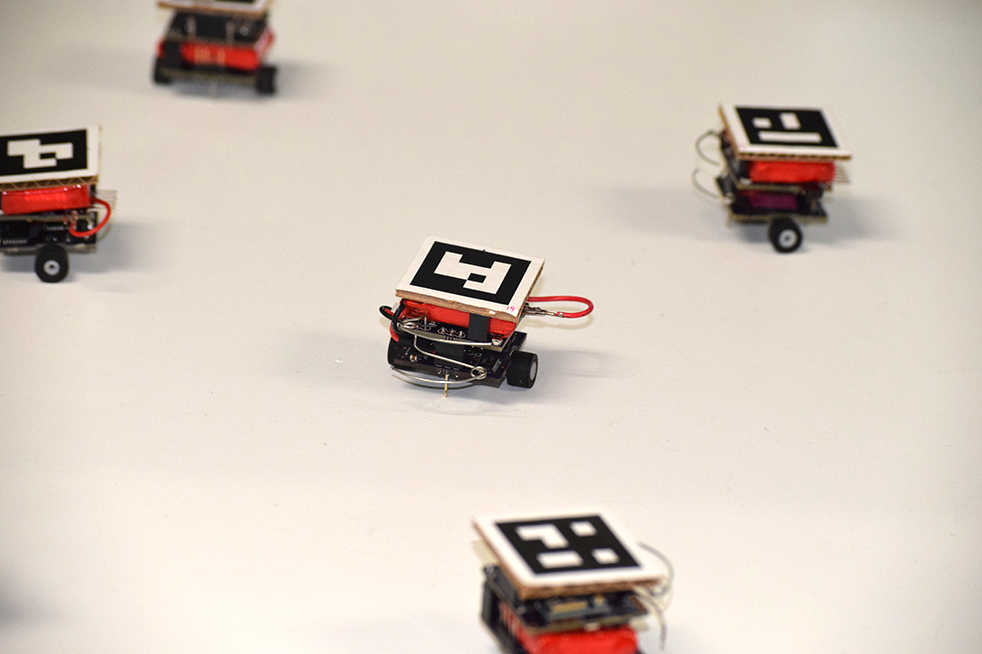The playground is a piece of childhood nostalgia, evoking in many the urge to abandon adulthood and to return to the carefree days of climbing and play.
Now, imagine a playground in miniature, and instead of slides and swings there is an open room and dozens of robots ranging from one square inch to nearly two feet tall.
This is the vision that world-renowned robotics professor Dr. Magnus Egerstedt and graduate student Daniel Pickem, along with their ever-growing team, have produced in the last year.
Their playground, the Robotarium, is to be the first of its kind and is designed as a testing ground for robotics researchers all over the world — a place for collaboration and in-depth research.
The project began as a single testing room for multi-agent systems, essentially robot teamwork, on the ground floor of the Tech Square Research Building, but traveling from the office several floors up was inconvenient for
the researchers.
They decided to build a miniature version of their room upstairs on a small table for easier access and then began building their own small robots, each of which is about one square inch by two inches tall.
During this transition, the pair hit upon a new idea in the form of a remote-controlled testing ground that could be shared among other researchers.
“The goal here is to allow other researchers to access [the Robotarium] remotely over internet and then upload their code so they can test the algorithms they can currently only test in simulation,” Pickem said.
Since then, the National Science Foundation has taken an interest in their work and provided them with grants totaling $2.5 millon, which will provide for four more years of research and production.
There are currently 4-5 professors working on the project alongside 10 graduate students from Georgia Tech and a small fleet of nine homemade robots.
Eventually, however, they hope to have as many as 200 robots of all shapes, sizes, and functions — including aerial drones.
The team has a classroom picked out in Van Leer that will have different sections for multiple projects and glass walls so Tech students can watch the robots carrying out the algorithms at any time. Researchers will be able to watch their projects via webcams set up all around the room.
“The hope is that [researchers] upload the experiment descriptor file that tells you, ‘I need this many robots in these locations doing this control algorithm,’ and the system is going to take care of the rest,” Pickem said.
One of the biggest challenges the Robotarium team has faced has been expanding the program to be inclusive for many people.
“We just want to have a large target audience because users help you build a better instrument. They’re not passive consumers of information but they also give feedback to help make it better,” Pickem said.
“The plan is to eventually offer use of the system to all levels of education, from professional research all the way to high school robotics programs.”
This project will eventually have vast implications for the entire field of robotics, especially with regards to how robots interact with one another and with the world around them.
Virtual obstacles can be programmed into the system to force the robots to react to external stimuli, as well as to one another as they go about performing their various tasks.
The system even comes with virtual “bumpers” for the robots to keep them from being accidentally destroyed by a collision caused by a faulty algorithm.
Though the Robotarium proper has yet to be fully constructed, a small test version was build and tested in cooperation with robotic scientists with the University of California, San Diego.
The test lab is currently located near the office of Professor Egerstedt, where Ph.D. students and faculty alike test the setup and perform tests of their own.
In the future, perhaps even as soon as May 2016, Tech students will be able to watch the program grow in its new home in Van Leer. The project is expected to be completed and operational by 2017.
Graduate students should also keep an eye open for a robotics class offered by Egerstedt that will allow them to participate in the research process by operating miniature robots and conducting research in the Robotarium.
Already, preemptive precautions are being taken to ensure the safety of the robots in the
Robotarium. Aaron Ames, an associate professor in the mechanical engineering department, has developed an algorithm to prevent errant robots from colliding with each other and damaging themselves.
